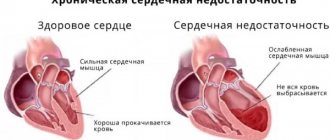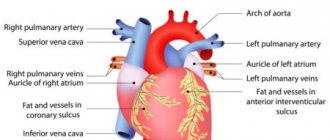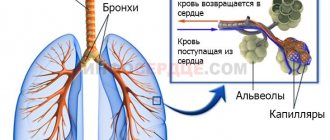The lack of a general concept of the optimal use of diuretics does not prevent their use in the complex treatment of many diseases based on the personal experience of practicing physicians.
Let's consider which diuretics are indicated for hypertension and which for heart failure, how they remove excess salts and water from the body, reduce the load on blood vessels and the heart, and prevent venous stagnation and serious complications.
General characteristics of diuretics (diuretics)
Diuretics (diuretics)
- effective treatments for acute and chronic heart failure, which are time-tested. On the one hand, diuretics can be called the most “banal” drugs, which, along with glycosides, are probably most often used for heart failure. On the other hand, the use of diuretics in this type of cardiac pathology is perhaps the most unexplored part in clinical practice. There are no direct data on the effect of diuretics on the clinical course (incidence of decompensation, mortality). According to some researchers (Opie LH, 1997, Taylor SH, 1995), such studies are unlikely to be conducted, because it is difficult to imagine the possibility of treating CHF only with diuretics in the form of monotherapy (and even a control group of patients receiving a placebo). We are quite aware of the negative aspects of using diuretics, but refusing them in most cases will lead to an increase in edema syndrome and circulatory decompensation.
If when prescribing ACE inhibitors or β-blockers we use target doses and clearly understand the stages of drug titration, then in the treatment of heart failure with diuretics we are guided only by general principles and this is where we are forced to “improvise”.
The main pathogenetic mechanism and the main clinical symptom of congestive heart failure
is the retention of sodium and fluid in the body, which leads to the development of edema, or, more precisely, the formation of edema syndrome. However, it is necessary to understand that this postulate is often exaggerated and not always in chronic heart failure, in particular FC I and II (functional class), there is obvious fluid retention, and yet diuretics, and in a broader sense, dehydration therapy plays a major role in the treatment of a large number of patients with chronic heart failure.
Classification of diuretics (diuretics)
The classification of basic medications that enhance the removal of excess water from the body, that is, those that we can classify as diuretics or diuretics, is traditionally based on the location of their action directly in the nephron.
To the main classes of diuretics (diuretics)
These include drugs that affect the permeability of the tubules relative to water and sodium, and are also capable of inhibiting reabsorption processes. These drugs, due to their effect on the processes of reabsorption of sodium and chlorine ions, received their name - saluretics.
The bulk of modern diuretic drugs (with the exception of uregitis) are derivatives of sulfonamides, more precisely derivatives of sulfomoyl acid. The sulfomoyl acid residue is also present in the molecules of thiazides (hydrochlorothiazide or hypothiazide), carbonic anhydrase inhibitors (acetazolamide or diacarb), loop diuretics (bumetanide, furosemide or bufenox). It is a well-known fact that diuretics that differ in their mechanism of action, strength and localization of the pharmacological effect in the nephron do not have fundamental differences in their chemical structure.
Below we will consider only those drugs that are most indicated in the treatment of congestive circulatory failure. Until recently, loop diuretics were widely used in the treatment of CHF. However, according to the general opinion of leading experts, they should be prescribed only to those patients who have severe manifestations of circulatory failure, while in the early stages thiazide diuretics can be used alone, or in combination with potassium-sparing diuretics, or in the form of combination drugs, such as diuretidin .
Differences in the pharmacological action of diuretics
depends on the location of their action directly in the nephron and their own mechanism of influence on reabsorption processes.
The region of the proximal renal tubules is affected by carbonic anhydrase inhibitors and osmotic diuretics.
Osmotic diuretics (diuretics) in the treatment of heart failure
Osmotic diuretics
(such as mannitol) have very limited use for the correction of heart failure, and in many clinical guidelines they are even contraindicated in severe circulatory decompensation. Although it should be noted that experienced cardiologists, especially in emergency and non-standard situations, remember this dangerous, but sometimes the last of the hypothetical means of treating critically ill patients with chronic heart failure.
Carbonic anhydrase inhibitors in the treatment of heart failure
This same area in the area of the proximal renal tubules is also influenced by carbonic anhydrase inhibitors, which are so named due to their unique mechanism of pharmacological action. Of the drugs in this group, diacarb (acetazolamide) is usually used in medicine.
Diacarb (acetazolamide) is a fairly weak diuretic from the pharmacological group of carbonic anhydrase inhibitors, which acts on the area of the proximal renal tubules. Diacarb is the only diuretic drug that acidifies the environment and increases the pH. Acetazolamide is used as an additional therapy during long-term use of powerful diuretics to prevent the development of refractoriness to loop diuretics
. For this purpose, a person is prescribed Diacarb at a dose of 250 mg 2-3 times a day for 3-4 days, followed by a break in treatment.
It should be noted that with normal indicators of the acid-base balance of the body (that is, in situations where there is no alkalosis), the diuretic effect of diacarb is very weak. Another situation occurs with metabolic alkalosis, in which excess bicarbonates occurs. The diuretic effect of carbonic anhydrase inhibitors is significantly potentiated, which is accompanied by increased exchange of sodium ions for hydrogen ions, inhibition of the reabsorption of sodium ions and an increase in diuresis. In such cases, carbonic anhydrase inhibitors can become a very important aid in diuretic therapy for patients with decompensated stages of congestive heart failure, which is usually, unfortunately, forgotten by general practitioners and even highly specialized specialists.
Contraindications
Diuretics for the treatment of hypertension and other diseases are prohibited from taking if there are the following contraindications:
- hypokalemia;
- diabetes;
- individual intolerance and hypersensitivity to the active ingredients of drugs;
- renal failure;
- cirrhosis of the liver;
- respiratory failure;
- ventricular arrhythmia;
- heart failure.
Diuretics are also contraindicated for pregnant women and breastfeeding mothers!
Diuretics are diuretic drugs used for the complex treatment of hypertension and stabilization of blood pressure. Since these medications have many varieties, contraindications and side effects, only the attending physician should select the drug on an individual basis!
Thiazide diuretics (diuretics) in the treatment of heart failure
Thiazide diuretics
have an effect on the loop of Henle in the cortical segment and in the proximal portion of the distal renal tubules, by blocking the activity of the sodium-chlorine transporter (“pump”). The effect of thiazide diuretics on the level of reabsorption of sodium ions and, accordingly, on the volume of diuresis is insignificant (at a level of 30 to 50% of the initial urine output) and is observed only with normal renal function (creatinine clearance more than 30 ml/min).
Hydrochlorothiazide
(hypothiazide, hydrex, diclothiazide, dihydrochlorothiazide, esidrex, oretic, benzothiazide, etc.) - is the drug of choice for the treatment of moderate stages of chronic heart failure. At doses of hypothizid up to 25 mg in humans, it practically does not cause the development of electrolyte disturbances and side effects. At doses above 75 mg, the incidence of side effects significantly increases. The maximum pharmacological effect of oral administration of hypothiazide occurs 60 minutes after administration with a duration of action of 12 hours. The absorption of hydrochlorothiazide (as well as diuretics of other groups) is significantly reduced by food intake, therefore the recommended time of taking the drug is in the morning on an empty stomach. The best combination of thiazide diuretics is with ACE inhibitors, which makes it possible to potentiate the diuretic effect while reducing the number of side effects.
Indapapamide
has a weaker natriuretic effect compared to thiazide diuretics, but unlike them, it has pronounced vasorelaxant properties. This is due to the ability of indapamide to enhance vasodilatory humoral mechanisms (synthesis of prostaglandin PGE2) and inhibit pressor stimuli by reducing the sensitivity of the vascular wall to the action of catecholamines and angiotensin II. Due to its high lipophilic density, indapamide selectively accumulates in the vascular wall, which ensures its long-lasting vasorelaxant effect. Prescribed 1 time per day.
Chlorthalidone
(hygroton, oxodoline, saluretin, urandil) - characterized by the longest duration of action among diuretics - 24-72 hours.
Clopamide (Brinaldix, Aquex)
- unlike other diuretics, it does not reduce, but increases the tone of the veins, due to which it does not cause orthostatic reactions.
Metolazone (zaroxoline)
— according to the chemical structure, it is a derivative of quinazoline; according to the mechanism of action, it belongs to the pharmacological group of thiazide diuretics.
Metolazone is a fat-soluble pharmacological drug that easily diffuses into the epithelial cells of the cortical segment of the distal loop of Henle. Absorption and dissemination of methazolan is very good despite the development of decompensated cardiac and even renal failure. From a positive point of view, this effect differentiates methazolan from other thiazide diuretics. Another advantage of metolazone is its long-lasting (up to 24 hours) action. The above properties make the combination of metolazone with loop diuretics one of the most effective in the treatment of chronic heart failure
.
Loop diuretics (diuretics) and treatment of heart failure
The most powerful diuretics are loop diuretics (for example, uregit, furosemide, torasemide, bumetanide), which inhibit the activity of a special ion transporter Na + / 2Cl- / K + in the epithelial cells of the renal tubules throughout the ascending part of the loop of Henle. The diuretic effect of these drugs is the most powerful (an increase in the level of diuresis with adequate dosing is more than 100% of the initial one) and, importantly, persists even with the development of renal dysfunction (with a creatinine clearance of at least 5 ml per minute).
The additive properties of loop diuretics are their ability to stimulate the synthesis of renal vasodilating prostaglandins, primarily prostaglandin E2 (PGE2), and somewhat inhibit the activity of carbonic anhydrase. An increase in PGE2 synthesis is associated with an additional potentiation of the reabsorption of sodium ions in the ascending loop of Henle and inhibition of water reabsorption in the collecting ducts. Based on the above, loop diuretics are rightfully considered the drugs of choice in the treatment of patients with congestive forms of chronic cardiac decompensation.
The most studied, well-known and used of the powerful loop diuretics is furosemide (synonym: Lasix). The onset of the effect of furosemide develops 20-30 minutes after application, the maximum diuretic effect develops after 1-2 hours, with a pronounced diuretic effect lasting up to 6 hours. Lasix has a renal route of excretion from the body in the following proportion: 60% - the native drug and 40% - its metabolites. Furosemide is most often prescribed in the morning on an empty stomach once a day. With the development of severe heart failure, doses of furosemide to a person vary from 20 to 500 mg and above, especially with edema refractory to therapy.
Ethacrynic acid
(synonym - uregit) is also a representative of loop diuretics, which is used for the same indications and for the same purpose as furosemide. It has similar pharmacodynamic effects, but affects other enzyme systems of the distal part of the loop of Henle. Uregitis is excreted by the kidneys in the proportion: 65% - the native drug and 35% - metabolites of ethacrynic acid. Therefore, in case of severe edema, the use of uregitis instead of furosemide or their combination can provide an additional diuretic effect. Standard doses of uregitis for humans are 50-100 mg; if there is special clinical need, they can be increased to 200 mg.
Bufenox (Bumetanide) - a powerful diuretic
, which disrupts the processes of reabsorption of chlorine and sodium ions in the thick section of the ascending loop of Henle. In standard situations, it is prescribed to a person in doses of 0.5-2 mg (however, its maximum dose can be 10 mg per day). Bufenox is prescribed in the morning on an empty stomach, like all other classes of diuretics. The onset of the diuretic effect develops after 15-30 minutes, a maximum of 1-2 hours, with a duration of up to 6 hours. It has a renal excretion route in the proportion: 60% - the native drug and 40% - bumetanide metabolites. It is possible to replace Bufenox with uregit or furosemide, as well as prescribe its combination with them in patients with severe forms of edema syndromes in chronic heart failure of functional classes III - IV (FC).
Demadex (active ingredient - torasemide)
- the most effective modern diuretics. Torsemide belongs to the group of loop diuretics. The bioavailability of torasemide is several times higher than that of furosemide (its bioavailability indicators reach 85-90% even in decompensated chronic cardiac decompensation). The drug is 80% metabolized in hepatocytes, due to which renal failure has virtually no effect on the pharmacodynamic properties of torasemide.
Folk remedies
Medicinal infusions and decoctions prepared from herbs and berries have a milder diuretic effect. Folk remedies also have less pronounced side effects. The most effective are decoctions and infusions from the following medicinal plants:
- elderberry, viburnum;
- horsetail;
- chokeberry, juniper;
- birch buds;
- string, chamomile;
- bearberry (shoots, leaves);
- cranberry;
- nettle.
Among the very effective and at the same time safe remedies, we would like to point out the herbal collection “Brusniver”. It includes the following herbal components:
- series;
- lingonberry leaf;
- St. John's wort;
- dog-rose fruit.
To enhance the therapeutic effect, bearberry leaves are added to the drug, which have antimicrobial, antiseptic, and anti-inflammatory effects.
Drink this herbal mixture in the form of regular tea. You can also prepare an infusion from herbs. Fill one package of the drug with water (100 ml), cover with a lid, and leave. After 30 min. the infusion is ready for use. You need to drink the finished product 3 times (the liquid should be heated to 30 degrees). The treatment course lasts 2 – 3 weeks. After a break of 10 days it can be repeated.
Canephron is considered another safe diuretic. It contains leaves of lovage, rosemary, centaury. The drug eliminates swelling, reduces spasms, relaxes smooth muscles, disinfects the urethra, and relieves inflammatory processes in the genitourinary system.
Take Canephron in this way:
- adult patients – 2 tablets or 50 drops of solution (three times a day);
- children over 6 years old – 1 tablet or 25 drops (three times a day);
- patients under 6 years of age - 15 drops of solution (three times a day).
This drug has virtually no contraindications. It is not prescribed only to children under one year of age and to patients with ulcers (acute stage).
Important: Medicinal plants can cause an allergic reaction in the body, so their use requires prior consultation with a doctor. . Diuretics are considered an effective adjunct to antihypertensive therapy, but should not be overused
Medicines from this group are also used for emergency treatment of severe edema. They are taken in small courses under the supervision of a doctor.
Diuretics are considered an effective adjunct to antihypertensive therapy, but should not be overused. Medicines from this group are also used for emergency treatment of severe edema. They are taken in small courses under the supervision of a doctor.
Potassium-sparing diuretics (diuretics) and heart failure therapy
It should be noted that in the zone of the distal renal tubules active ion exchange occurs, in particular, sodium ions for potassium ions. This ion exchange process is regulated primarily by the aldosterone system, which affects specific receptors located in the area of the distal renal tubules. Based on the above, drugs that affect the distal renal tubules are called potassium-sparing diuretics. These diuretics cause a relatively weak increase in diuresis (no more than 20% of the initial level). Their mechanism of action is based on inhibition of sodium reabsorption. Due to this, the urinary excretion of potassium ions is inhibited.
The above group of pharmacological drugs includes a competitive aldosterone blocker, which is widely used in clinical practice - aldactone (veroshpiron).
Aldactone (veroshpiron, spironolactone)
- the diuretic effect itself is not very strong, because a small amount of sodium is reabsorbed in the distal renal tubules. When used in combination with thiazide and loop diuretics, the pharmacological effect of aldactone (spironolactone) is significantly potentiated. It should be noted that the feasibility of long-term use of high doses of the drug in humans, dogs and cats with early and moderate stages of heart failure has not been proven. If decompensation of circulatory failure occurs, then the need to use veroshpiron (aldactone, spironolactone) in high dosages, as well as in combination with other diuretics, does not raise any doubt. However, long-term use of aldactone, particularly in combination with ACE inhibitors, is questionable.
Aldactone is used for people in a dose of 150-300 mg (6-12 tablets). It is better to take the entire dose of spironolactone in the morning, in extreme cases twice a day, taking it in the first half of the day (for example, at 8-00 and 12-00), this is due to the fact that the concentration of aldosterone in the blood is maximum in the morning.
In addition, the group of potassium-sparing diuretics
includes direct inhibitors of sodium channels of distal renal tubules (in apical cells) - amiloride and triamterene. A non-competitive blocker (antagonist) of aldosterone is triamterene (Amterene, Direnium, Ditex, Noridil), which is used in a dose of 50-150 mg per day. The onset of action is 2 hours after administration, duration is 12 hours. Diuresis and natremia increase within 20% with a combined decrease in the level of potassium excretion (up to 30%). The combination of thiazide diuretics with triamterene in a ratio of 1:2 is considered optimal. Based on the above properties, the drug diuretidine was created, which contains 25 mg of triamterene and 12.5 mg of hydrochlorothiazide in one tablet. The minimum daily dose of diuretidin for a person with heart failure is 2 tablets, the optimal is 4 tablets, the maximum is 8 tablets.
Possible complications
When taking diuretics, patients with heart failure should regularly visit a doctor and undergo examinations to identify possible complications.
Most often, the patient is at risk of metabolic disorders, increased azotemia or dehydration. The doctor determines how often the patient should visit the hospital. The frequency will depend on the severity of the disease, the health of the body, kidney function and the dosage of the drug. In addition, if a person is diagnosed with any other pathologies, then systematic examination may be more frequent.
Taking medications can cause a lack of potassium in the body, which causes acute arrhythmia. The rapid loss of biologically active substances is affected by both the drug itself and the systematic use of table salt in large quantities.
The use of aldosterone receptor antagonists simultaneously with ACE inhibitors most often threatens the progression of hyperkalemia. Potassium supplementation is usually excluded from therapy after use of aldosterone antagonists. The doctor must warn the patient that he should exclude all foods high in potassium from his daily diet. But, if a sufficiently large dose of the substance was introduced into the body, then taking supplements will have to be continued in minimal quantities.
When hypokalemia is diagnosed, additional medications cannot be stopped, as the patient’s metabolism worsens and the level of electrolytes in the blood decreases. Because of this, the risk of hyponatremia, hyperuricemia, metabolic alkalosis and HLP increases.
Hyponatremia is usually diagnosed in patients with CHF, poor mobility, ASD and elevated AFP levels. Taking pills can provoke the appearance of hyponatremia only if the medicine was taken in large doses. Signs of the disease are quickly eliminated with significant fluid intake.
If the first symptoms of pathology appear, magnesium is introduced into the body. It is prescribed to restore the body of patients who are prescribed a course of treatment with diuretics.
Principles for choosing diuretics (diuretics) for chronic heart failure
Principles for choosing diuretics (diuretics) for chronic heart failure
. In the initial stages of chronic heart failure (FC I; first stage of CHF according to the classification of V.Kh. Vasilenko and N.D. Strazhesko), diuretics should not be used.
In case of moderate CHF (class II, and sometimes even class III; stage IIA according to the classification of V.Kh. Vasilenko and N.D. Strazhesko) and preserved renal function, thiazide diuretics are the drugs of choice
.
As the severity of decompensation of cardiac dysfunction increases, prescribe stronger loop diuretics or a combination of two or three diuretics. A combination of loop or thiazide diuretics with carbonic anhydrase inhibitors is always useful. After 2 weeks of active diuretic therapy, metabolic alkalosis forms in the body. Due to metabolic alkalosis, the effectiveness of loop and thiazide diuretics decreases, and the effectiveness of diuretics - derivatives of carbonic anhydrase inhibitors - increases. Based on the above, the use of diacarb 0.25 mg 3 times a day for 3-4 days can be twice as beneficial.
A combination of potassium-sparing drugs with active (loop or thiazide) diuretics can also be very effective. Triamterene or aldactone prevent the development of complications from the electrolyte balance and, like carbonic anhydrase inhibitors, have an acidifying effect and potentiate the effect of active diuretics. An example of such a combination would be the drug diuretidine
.
In severe stages, it is advisable to combine a thiazide diuretic with a loop diuretic (the best combination with metolazone) or two loop diuretics with an aldosterone antagonist, in addition to this combination, diacarb, a carbonic anhydrase inhibitor, once every 2 weeks for 3 days.
Loop drugs
Loop diuretics have a strong diuretic and arteriolodilating effect on the body. They are most effective in cases of renal failure and when the patient's plasma levels return to normal. Loop drugs act faster and stronger than others due to the mechanism of action itself. Despite all the advantages of this group, they cannot be taken constantly or for a long period, as they lead to addiction and the development of metabolic alkalosis, hyperglycemia, hyponatremia and other side effects. The patient develops arrhythmia, the general condition worsens, convulsions and muscle tension are noted. This is expressed in the loss of large doses of potassium and disruption of water-salt balance. The use of these diuretics depends on the severity of the patient’s condition, the level of electrolytes in the blood, the condition of the kidneys, etc. Therefore, loop diuretics are prescribed for a single dose in acute conditions or once every few days to eliminate swelling.
Tactics of therapy with diuretics (diuretics)
Tactics of therapy with diuretics (diuretics). Therapy with diuretics for patients with chronic heart failure occurs in 2 phases
:
- active therapy
- maintenance therapy
The goal of the active phase of therapy is to eliminate excess accumulated fluid in the body, which clinically manifests itself as edema. During this phase, it is necessary to provide forced diuresis with excess urine excretion, in comparison with the water consumed by 800 - 1000 ml per day. It is also necessary that body weight decrease daily by 750 g - 1000 g per day.
The principle of calculating the dose and frequency of use of diuretics is quantum satis, or their dose is titrated from low doses to maximum doses to achieve the desired clinical effect. Treatment begins with low starting doses of diuretics (for hydrochlorothiazide ≤ 50 mg, for furosemide ≤ 20-40 mg, for uregitis ≤ 50 mg for bufenox ≤ 1 mg), which can then be increased, if necessary. It should be remembered that diuretics should always be prescribed in conjunction with ACE inhibitors. This combination is very effective, since both of its components significantly enhance and potentiate the pharmacological effect and neutralize each other’s side effects. Large-scale clinical studies have established that the combination of diuretics and ACE inhibitors is safe, which makes it possible to avoid the development of multiple side effects characteristic of diuretics.
Of utmost importance in the adequate use of diuretics is the collection of anamnesis, which allows one to assess the effectiveness of previously prescribed diuretic therapy. It should be added that a history of indications for the use of loop diuretics (particularly in patients with compensated stages of heart failure) does not contradict the fact that thiazide drugs, which are considered weaker, may show higher effectiveness of dehydration therapy. However, in patients with class IV chronic heart failure who use 80 mg of furosemide per day without sufficient effect, an attempt to use 50 mg of hydrochlorothiazide is inappropriate.
When the patient's state of optimal dehydration is achieved, he is transferred to the maintenance phase of therapy. During this period, the volume of water drunk should not exceed the amount of urine excreted (in the optimal case, the patient should excrete 200 ml more urine than the liquid drunk). Emphasis should be placed on the fact that the patient's body weight must remain stable. The main principle of the maintenance phase of therapy is the use of selected diuretics every day, which makes it possible to maintain stable both the patient’s body weight and diuresis. The practice of using “load” doses of diuretics for 2-3 days is inappropriate and difficult to tolerate in patients with chronic heart failure
. It is better to prescribe the patient 12.5-25 mg of hydrochlorothiazide per day rather than 40-80 mg of furosemide once every 5-7 days.
Dehydration at different stages of heart failure
Active stimulation of urination is indicated only in the presence of severe congestive processes. In this case, you need to achieve urine excretion of 1 liter more than the amount of fluid you drank, that is, every day your body weight decreases by about 1 kg. After this, they switch to maintenance doses that will ensure equality of water intake and urine output, and body weight remains constant.
Depending on the functional class of HF, there is a peculiarity in the prescription of drugs.
| Functional classes of CH | Recommendations |
| First and second without stagnation | no diuretics required |
| Second with stagnation | Hypothiazide, Trifas |
| Third (decompensation) | Lasix or Hypothiazide with Veroshpiron, for maintenance treatment they need low doses with Diacarb |
| Fourth | Lasix, Hypothiazide, Indapamide together with Veroshpiron and Diacarb. Three days a week, then a week off, then repeat. |
Characteristics of the formation of refractoriness to diuretics (diuretics)
Since almost all modern diuretics are derivatives of sulfomoyl acid, they are characterized by general principles of developing refractoriness to treatment with diuretics and, accordingly, general principles of preventing this situation.
The etiology of the development of refractory edematous syndrome is:
- Progression of chronic heart failure.
- Development and progression of prerenal chronic renal failure.
- Arterial hypotension.
- Excessive hyperactivation of neurohumoral systems.
- The presence of acid-base metabolism disorders and imbalance of electrolytes in the blood serum.
- Hypoproteinemia and cachexia.
- Formation of tolerance to the pharmacological action of a diuretic.
“Early refractoriness” to diuretics or “inhibition stage.” It forms literally after several days of active treatment with diuretics. The etiology of this phenomenon is the activation of neurohormones (angitensin, catecholamines, aldosterone and vasopressin), as well as a reaction to hypovolemia, which has developed sharply. The probability of “early refractoriness” to diuretics is higher, the more persistently the doctor begins dehydration therapy for the patient. Excessively high diuresis with an excess of the daily volume of urine excreted over the amount of fluid taken by ≤ 2.5 l guarantees the development of “rebound” refractoriness to therapy. To prevent “early refractoriness” to diuretics, it is necessary to combine diuretics with ACE inhibitors.
“Late refractoriness” to diuretic therapy occurs 1-3 months after the start of treatment. The etiology of “late refractoriness” is hypertrophy of epithelial cells in response to increased absorption of electrolytes.
Overcoming refractoriness to diuretics (diuretics)
To prevent the development of refractoriness to diuretic therapy
it is necessary to use a complex of preventive methods.
- Strictly limit the consumption of kitchen salt, not water!
- The use of diuretics is strictly intravenous.
- Use of high doses of diuretics. There is evidence that in some cases it was possible to overcome refractoriness to diuretics with intravenous use of furosemide (Lasix) in a daily dose of up to 2000 mg. In particularly difficult situations, it is recommended to administer a bolus of furosemide (Lasix) intravenously at a dose of 40-80 mg, followed by its infusion at a rate of 10-40 mg per hour for 2 days.
- Normalization of blood pressure: - abolition of vasodilators, especially nitrates, which are prescribed without indications, regarding the diagnosis of coronary heart disease - if there is a need to use steroid hormones (intravenous prednisolone 180-240 mg orally), cordiamine; - in critical cases, intravenous infusion of dopamine is used
- Stabilization of the neurohumoral profile (use of ACE inhibitors and aldosterone antagonists, in particular aldactone / veroshpiron).
- Normalization of the protein profile, correction of hypoalbuminemia - use of human donor albumin (200-400 ml per day for people), together with diuretics.
- It is possible to additionally use drugs that help increase the glomerular filtration rate (for example, aminophylline and positive inotropic drugs).
- Combination of several representatives of diuretic pharmacological drugs.
Combined use of active diuretics. All three of the most commonly used loop diuretics—Uregit, Lasix (furosemide), and bumetanide—are believed to have high and approximately equal diuretic efficacy.
Although in modern therapy of internal diseases of humans and animals there is a huge number of foreign and domestic clinical studies, according to which there are recommendations for the use of the new and most powerful loop diuretic - torasemide, sufficient experience in its use has not yet been accumulated.
The most beneficial is the combination of loop diuretics with thiazide
, due to which sodium reabsorption is blocked in various parts of the nephron. This combination is clinically more justified than the use of a combination of two loop diuretics, for example furosemide with uregit, furosemide with bufenox, furosemide and torsemide. It is obvious that a combination of two drugs from the group of loop diuretics can overcome tolerance to the long-term use of one of them. However, thiazide diuretics have an effect on the distal nephron; therefore, the combination of Lasix (furosemide) with hypothiazide will significantly expand the zone of inhibition of sodium reabsorption in the tubules. In addition, the above combination affects two different electrolyte transporters in the tubules at the level of the apical cells.
The most popular diuretic combination in the world is the combination of Lasix and Metolazone. As previously mentioned, metolazone is the most lipophilic and long-acting thiazide diuretic, which provides an additive effect of this combination, in particular in the development of renal failure. However, the combination of a loop diuretic (furosemide or torsemide) with hypothiazide and, perhaps, with indapamide (unfortunately, this diuretic has not yet been studied in chronic heart failure) can also significantly increase the effect of dehydration therapy.
It can be concluded that the optimal principle of combination therapy with diuretics for treatment-refractory congestive heart failure is a combination of high doses (furosemide) of Lasix, which must be administered intravenously, with veroshpiron and a thiazide diuretic, and after 2 weeks from the start of therapy should be added to the above drugs carbonic anhydrase inhibitor (diacarb) for 3-4 days.
It should also be noted that situations arise when even the above measures do not always make it possible to overcome refractoriness to dehydration therapy. In such cases, mechanical removal of excess fluid from body cavities (thoracentesis, pericardiocentesis and laparocentesis) or extracorporeal dehydration methods (hemodialysis or isolated ultrafiltration) should be used.
Dehydration therapy is a critical component of successful treatment for patients with congestive heart failure. It is worth remembering that complex pathogenetic neurohumoral mechanisms take part in the formation of edematous syndrome, and improper dehydration can only cause the development of severe side effects and rebound retention of sodium and water ions in the body. The use of diuretics must be clearly justified
, must be combined with drugs that provide neurohormonal modulation, such as aldosterone antagonists and ACE inhibitors, to be only one of the links in the rational therapy of decompensated patients using an individual approach in each specific case.
^Top
Side effects
The use of Furosemide may result in the following side effects:
- Disturbances in the functions of the nervous system, manifested by dizziness, muscle weakness, headache, tetany, apathy, adynamia, paresthesia, drowsiness, lethargy, weakness, confusion;
- Blood and circulatory system: aplastic anemia, hemolytic anemia, eosinophelia, thrombocytopenia, agranulocytosis, leukopenia, decreased circulating blood volume, tachycardia, arrhythmia, decreased blood pressure (including orthostatic hypotension), collapse;
- Disorders of water-salt metabolism, including dehydration and, as a consequence, an increased risk of thrombosis/thromboembolism, hypovolemia, hypomagnesemia, hypochloremia, hypokalemia, hypocalcemia, hyponatremia, metabolic acidosis;
- Digestive system: irritation and dryness of the oral mucosa, colic, anorexia, increased activity of liver enzymes, hepatic encephalopathy in patients with hepatocellular insufficiency disease, exacerbation of pancreatitis, cholestatic jaundice, constipation and diarrhea, vomiting, thirst, nausea, loss of appetite;
- Genitourinary system: decreased potency, interstitial nephritis, hematuria, oliguria, acute urinary retention (in patients with prostatic hypertrophy);
- Hypersensitivity reactions, including exfoliative dermatitis, urticaria, purpura, necrotizing angiitis, vasculitis, erythema multiforme, chills, pruritus, photosensitivity, fever, anaphylactic shock;
- Other: bullous pemphigoid, chills, fever.
When administered intravenously: patent Botalov duct, nephrolithiasis, nephrocalcinosis in premature infants, thrombophlebitis.










